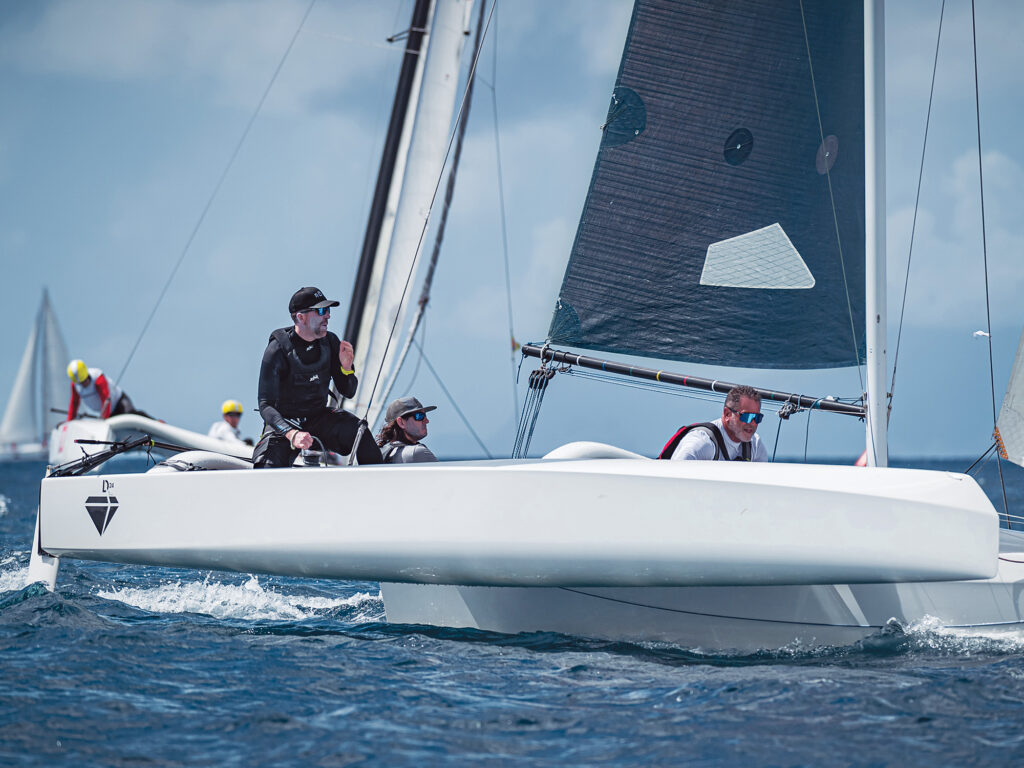
I’d love to look around and enjoy the scenery, but I can’t take my eyes off the leeward bow that’s slicing through the Caribbean at 20 knots. I’d been advised earlier: The fine line between full-tilt and pitchpole is somewhere right around the chine on the wave-piercing bow. The warning also came with a caveat: “The faster we go, the safer we go.”
That’s the wisdom of Pierre Altiere, a master of the Diam 24 trimaran, with whom I’ve scored a ride for the St. Maarten Heineken Regatta. The point of the exercise is to experience firsthand the hottest one-design fleet in the Caribbean. Altiere’s boat is named Cry Baby, which I may eventually come to understand, but right here, right now, all I can think about is the gust breathing down my neck.
I ease the gennaker sheet in my hand and watch the bow submerge. Oh, sh-t, I think. Here we go. I’ve seen pictures of Diams tumbleweeding, but the bow porpoises. A ball of seawater smacks the forward beam and explodes into a cloud of sunlight sparkles and foam.
With a jab of the tiller bar, Altiere redirects the boat and reloads the sails. The daggerboard hums a few octaves higher as we skim across the shallow blue flats of Phillipsburg Bay. It’s thrilling and a little terrifying, and thankfully, we’re just getting started.
It’s an early March morning on St. Maarten’s Kim Sha Beach, on the bustling Dutch coast where six identical 24-foot trimarans sit under palm trees, surrounded by umbrellas, chaise lounges and rental kayaks. Four other Diams swing on their anchors a doggie-paddle’s distance from the beach. This is the homegrown Diam 24 One Design fleet, which in a few short years has multiplied from three to 10. Soon enough, Altiere promises, if his Diam dream scheme pans out, we will be looking at as many as 20.
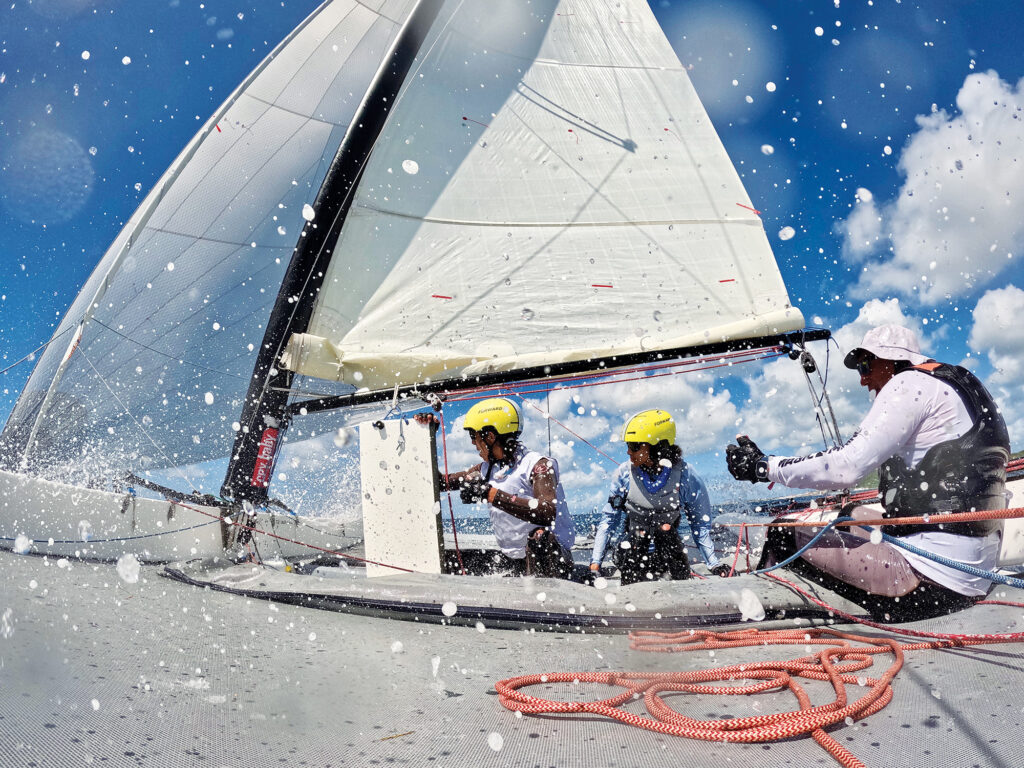
Altiere, I’m told, is the spark, the one who started it all, and judging by the parade of sailors seeking him out for advice, parts, assistance and you name it, it’s obvious that not much happens without Altiere. As we rig our own boat, interrupted by phone calls and favors, he gives me a quick lowdown on the Diam, which was created by Vianney Ancelin, a French multihull sailor and boatbuilder. Ancelin’s vision was a recreational multihull that average sailors could handle—sporty but not lethal, high-tech but not overpriced. That was the idea before the Tour de France a Voile—a multistage regatta—adopted the Diam as its official one-design. Pro race teams with million-dollar budgets promptly priced amateurs out the class, and then the pandemic put a fork in the Tour. The builder, ADH Inotec, stopped production at just north of 100 boats. With the Tour on hold, however, there was suddenly a pile of secondhand race-ready boats, many with containers full of unused spares, most fetching $20,000 to $30,000.
Enter Altiere, the tall, jovial and hard-charging Frenchman who taught at a sailing school as a young man and then opened his own in Tahiti before landing in St. Maarten, where he operates a thriving private catamaran charter business. As a top-level F18 catamaran sailor not far back in the day, a friend once invited him to race a Diam in France. He knew little to nothing about the boat at the time. “As an F18 sailor, I knew what I was doing,” he says. “I hadn’t raced [in Brittany] in 20 years, but we somehow made it onto the podium, everyone applauded us, and I enjoyed it so much that the next day we started talking about becoming an agent for North America.”
He did, but the big continent was impossible to crack, so he pivoted to a better plan: bring potential buyers to the boat and give them a taste. Step 1: Establish a Diam base at home in St. Maarten and show off the boats. Step 2: Enter them into the region’s big-draw regattas: the Heineken and Les Voiles de St. Barth.
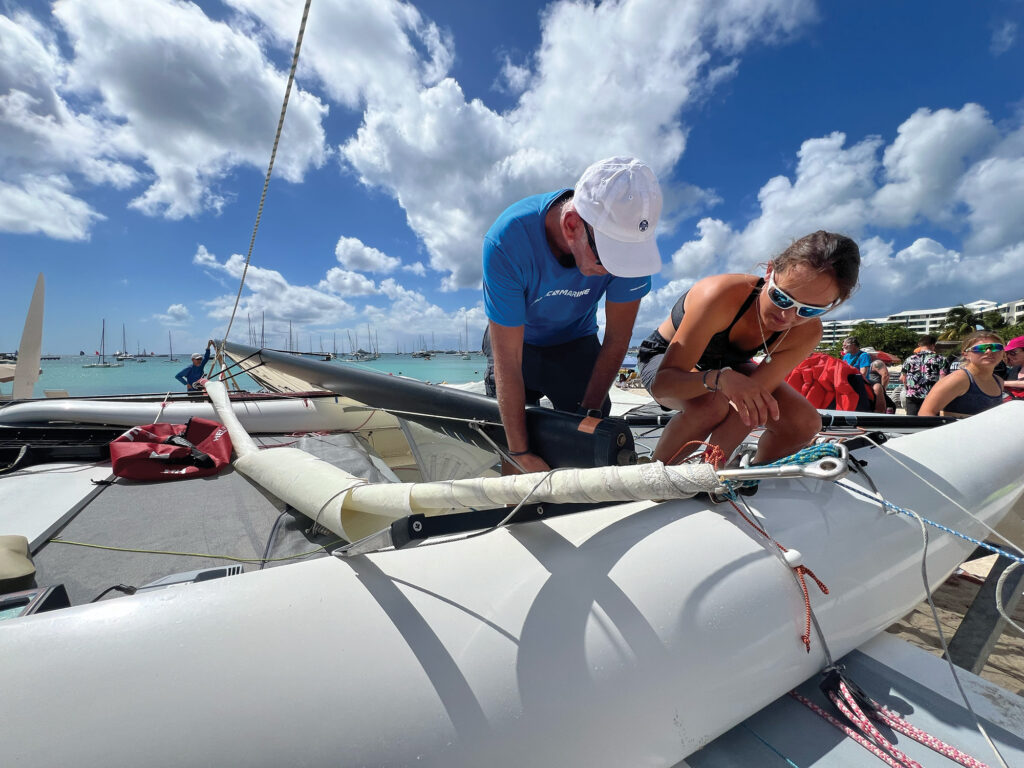
“There’s nothing better than an easy flight to St. Maarten, throwing your bag in the hotel, and jumping onto a Diam that same day,” Altiere says. “Just like me, I was offered a chance, I had a great experience, and right after that, I bought a boat. That’s the easy-regatta concept here: Fly in, race, celebrate, fly out.”
And that’s how “sort-of” New Yorker Adam Holmes and his buddies Ben Ferraro and Bob Young were lured to Kim Sha in late March for the Heineken Regatta. Holmes, an advertising executive and Long Island-based racing sailor, had heard about the Diam fleet through a friend in St. Maarten, who connected him with Altiere, who had one charter boat available for the Heineken Regatta.
How much for a good time?
Five-grand—tops—according to Holmes’ mental math, and that was with a top-shelf condo, on the water, for a week. Altiere’s charter fee, which included four days of racing and two days of practice, was only $3,700—worth every penny on the speed-to-dollar scale. For months, the three of them exchanged Diam sailing videos that they found online. “That was like the start of the adrenaline rush,” Young says, and when they jumped on board for their first figure-it-out-yourself session in St. Maarten, the real thing was a real rush.
“We didn’t get a very detailed briefing before our first sail,” Holmes says. “At one point on the first practice day, we were sending it at like 19 knots, and the hull was so far underwater. Bob had the kite strapped in hard and we were just flying…like really, really on the edge. The Diam guys following us in the RIB and yelling at us in French were freaking out because we hadn’t yet signed any paperwork.”
“At the time,” Ferraro adds with a laugh, “we had no idea we were on the edge—we didn’t know any better.”
But with a few more hours of practice and less than 30 minutes of one-on-one with Altiere, they were ready enough to throw themselves straight into the races. Ferraro was nominated to drive, Holmes got the back-breaking main trimmer’s spot, and Young took on the busy end at the front of the cockpit.
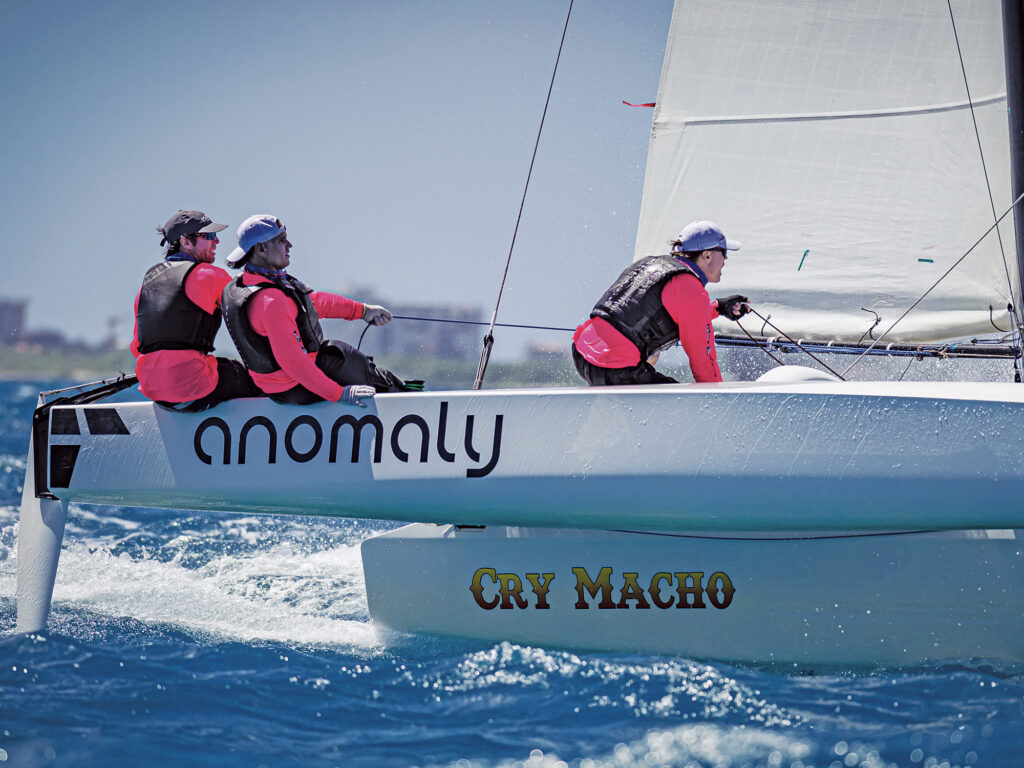
On the first morning, the breeze is up to 15 knots, and even though the start is in 90 minutes, the vibe on Kim Sha is bizarrely relaxed. Beach attendants rake the sand for the inbound tourists while sailors wander about in farmer-john wetsuits, surf trunks and rash guards, most of them conversing in fast-paced French and tinkering with their boats.
Among them is Erick Clement, one of the originals. He is a master of the Caribbean multihull racing scene and enjoying his retirement from F18 catamaran racing. Daily yoga, and healthy eating keep him young and in Diam-worthy shape.
“The speed is good and the boat is not complicated, but you have to get a feeling for it,” he tells me in his best broken English. “When everything is right, the steering is balanced perfectly, and you listen for the noise of the daggerboard—that helps you know when it is right.”
As a simple three-crew boat, the roles are straightforward. Whoever has the pleasure of helm also gets the traveler—the capsize preventer. The middle crew manhandles the insanely loaded mainsheet, trims the gennaker, and assists with dousing it. The forward crew is responsible for the self-tacking jib sheet, sail controls (outhaul, cunningham, mast rotator), gennaker hoisting and the daggerboard. Between calling tactics and jibing angles, housekeeping the trampoline, and watching for traffic, it’s an active boat for all involved, especially when big-breeze buoy racing in St. Maarten.
“All crew are super-important,” Clement adds. “If one is not playing the game, you can’t do anything. You have to have a good balance with each other.”
That will be a problem for us on Altiere’s Cry Baby because we are rotating new teammates every day. With us for the first day is a strapping young Frenchman named Corentin, who goes by Coco. He’s one of Altiere’s charter boat captains and has some Diam racing experience, which is good because we’re straight into the first start without a lick of practice. It’s a chaotic five minutes of weaving through rush-hour traffic: big custom raceboats, cruisers, bareboats and two 100-footers, all pinging the starting line.
The Diam will go from zero to 15 rapidly, but it’s not the kind of boat you can luff-and-hover on the start. Full speed is Altiere’s preferred approach, and with 45 seconds remaining in the opening sequence, he is stalking next to the committee boat, mentally calculating the layline and time to kill. But the other boats are stacking up at the starboard end, making what looks to be an impossible entry. But, hey, Altiere is the man and the defending champ. This is his domain. Who am I to doubt?
At 30 seconds, he booms, “OK. We go!”
And go we do, bearing away to full hum, straight toward the big catamaran committee boat. Just when it looks like he is going to pull off a high-speed barging start, Holmes and his crew tack in front of us and stuff the boat into irons—three sun-creamed deer in our headlights.
It’s either them or the committee boat, but Altiere pulls the hand break, and we coast to a near stop. The bow of our center hull disappears beneath the catamaran’s bridge deck, and the starboard bow just clears the cat’s starboard transom. I run forward and push off, and Altiere apologizes while cursing the New Yorkers for their erratic driving.
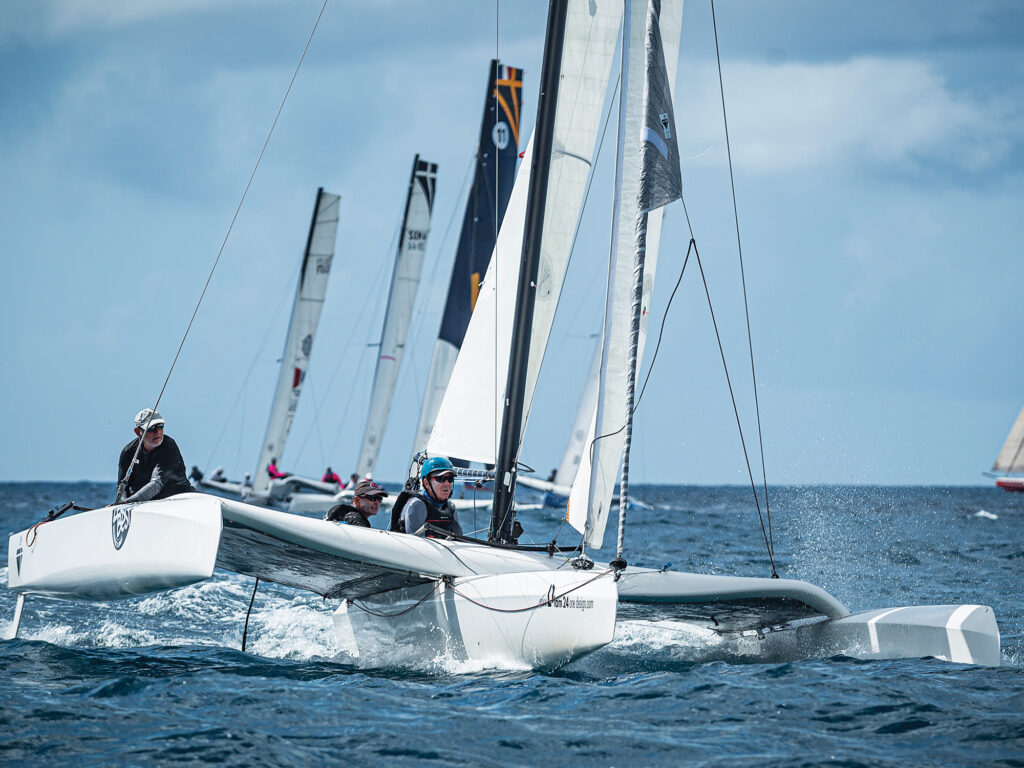
“I mean…it was our first race, and we were still trying to figure out how to tack the damn thing,” Young says. “That was a little nutty.”
“OK, let’s go,” Altiere shouts once again. More trim!” And with that, we’re chasing down the fleet. I pull the mainsheet as hard as I humanly can. The sail is board-flat and the telltales are streaming.
“More trim!” he shouts again. “We do it together.”
He reaches forward with his big right arm, grabs hold of the sheet with one hand, and together we grunt another 2 feet. The weather hull rises higher, and then the center hull breaks the surface. I’m staring at the line that Altiere had drawn on the bow with a Sharpie. That’s my fine-line guide for the week.
“More speed,” he says. “We will get them.”
I pull but get only another inch. He reaches in and gets another 6, finds his gear, and lets it rip.
The collective opinion on Kim Sha is that Altiere is the best sailor in the fleet, and I can see why. He effortlessly threads the trimaran around oncoming traffic, across big waves, and through giant puffs that pin other boats on their ear. He will dive to leeward of another boat and sail right through its lee. Downwind, he sits inside the center hull, hunched, with his hand behind him on the tiller bar, laser-focused. He senses every subtlety of the boat and knows what it will do before it does it. And more than once, when we sail into a lull and our speed drops, he puts his hand up in the air and says, “Bwaah…come on, wind, what is wrong with you?”
He’s seriously annoyed with the breeze for denying him his speed.
The first race is a windward/leeward blur, and we somehow manage a midfleet finish. Same for the others that follow, but our mishaps reflect our thrown-togetherness. We’re fast in a straight line thanks to Altiere’s skills, but every slip-up is a dozen boatlengths lost—and that’s no lie.
Back on Kim Sha, there’s a beach bar 10 feet from the boats. It’s got reggae, cold beer and cheeseburgers in paradise. The fellas from New York are happy to be back on the beach with their recovery juices in hand.
“That was kind of devastating,” Ferraro says. “We were miles behind on all the races, like it was not even close. We weren’t going to drink, but then all of sudden, we’re standing there with a drink in our hand and were like, ‘What just happened?’”
Young isn’t bothered at all about the results. He’s whipped, but it’s worth it: “All I remember was thinking, I’ve never gone that fast on a sailboat. I think our top speed was 20.7. The sound of the boat and that hum going at that speed was just like, holy sh-t. Let’s just hold on.”
With the wind forecast to peak into the mid-20s, the St. Maarten Heineken Regatta’s legendary around-the-island race is next on the to-do list. Big island, big breeze and it’ll be big-time fun, Altiere promises me when we meet at the beach and introduces me to Camille, another of his charter boat captains. She’s petite, and Altiere confesses he had miscalculated the wind forecast when lining up crew for the regatta.
“We will struggle a bit upwind because weight is very important,” he says, slapping a big hand on my shoulder and cracking a big smile. “But we will be very, very fast on the reaches.”
And he isn’t kidding.
To start our circumnavigation, the race committee dispatches us on a short upwind leg. Once we turn downwind and deploy the gennaker, we’ve got many miles of open-ocean high-speed tropical send. In these conditions, Altiere is in his element and sails right up to and past boats that got ahead of us on the upwind leg. Our top speed, according to my watch, is 22.9.
But every downhill has uphill, and way too soon we’re furling the gennaker, lashing it to the trampoline, rounding an orange tetrahedron, and pointing three bows into steep, wind-whipped waves.
“More trim!” is all I hear for the next hour, or “More speed!”
Each time, I pull with everything I’ve got, the rope shredding the palms of my cheap gloves. With only the leeward bow in the water, Cry Baby kisses wavetops, making this upwind slugfest that much more enjoyable as we short-tack the island’s coastline. After one final tack to port at the top of the island, Altiere gives us the command we’ve been waiting for: “Go gennaker, now!”
The moment that sucker fills, the daggerboard is singing, water is exploding through holes in the trampoline mesh, and we’re cruising at 20 knots. Altiere carves up and down following seas and reels in the boat to leeward of us as if it’s dragging a drogue. The three of us are pinned to the aft beam, weight back as far as it can possibly go. There will be no pitchpoling today. Lush green island to starboard, sparkling blue sea all the way to the finish. It’s heart-racing tropical sailing the likes of which I’ve never experienced.
Later, as I shuffle to a hotel shower, I get a pop-up alert on my Garmin watch that I’ve never seen before: “Recovery Time Delayed. A high level of activity today slowed your recovery.”
As if I need reminding.
The New Yorkers had a heck of time getting around, unaware of water pouring into an unsealed cockpit hatch, enough to have their Torquedo floating inside the hull. “We were hanging with everyone until we got to the top of the island,” Ferraro says. “But once we got around the top of the island, everyone just peeled away from us. We had no idea why.”
Hundreds of pounds of water sloshing around the center hull will do that to you.
Regatta organizers serve up a feast for the next day, with a full menu that includes a 20-mile distance race to Marigot Bay on the French side of the island, a windward-leeward race in the bay, and a return distance race. Our new crew for the day is 13-year-old local Optimist champ Sarah Micheaux, tiny and timid, but seemingly game for her first Diam outing. She speaks only French, so Altiere explains the ropes.
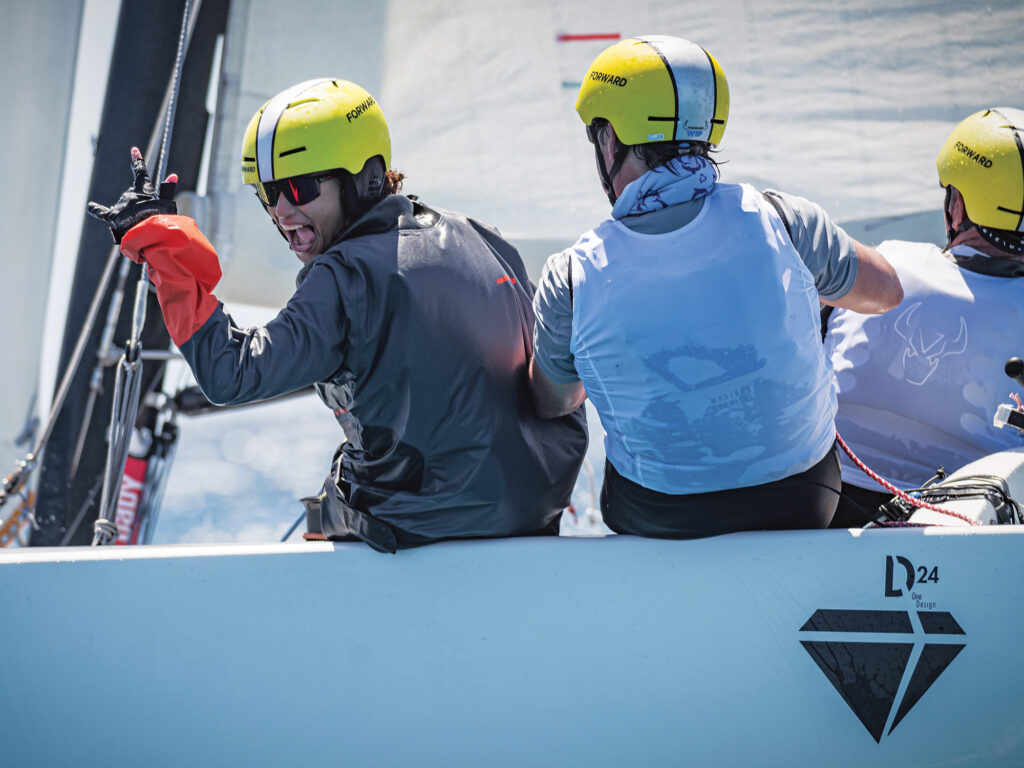
Before we even strike the line on a high-speed gennaker reaching start, Micheaux is shivering, puking, and white-knuckling Altiere’s leg. While redlining at 20 knots, he pats her on the back like a tender father, assuring her that all is well.
We round the reach mark with Micheaux out of commission, so he hands the tiller to me so he can go forward and rotate the mast by hand. It’s my first go at driving, and my tendency is to drive it like a monohull—oversteering through waves and feathering through the big gusts. Altiere corrects me and keeps goading me: “More speed. Even more speed. Good.”
All I have to do is bear away a few degrees, get the center hull unstuck, and the boat levitates with only the leeward bow punching through the waves.
“See?” he says. “Speed. Always more speed.”
After the ensuing and harried one-lap windward-leeward race in the bay, we’re lining up for the 12-mile return sprint, which is another shot-out-of-a-cannon gennaker start. Thankfully, this race has zero upwind sailing. This one’s a reach-fest, and this is why we reach through life.
“The sail back from Marigot was just epic,” Holmes says. “Just screaming. Unbelievably fun. We were finally starting to get a handle on the boat.”
On the fourth and final day, we’re back to buoy racing, and while there’s more tears than cheers on Cry Baby, the sort-of New Yorkers are feeling their mojo.
“We were in the mix,” Holmes says. “We had good starts, and we were with the group upwind. There are some cool photos of us kind of like leading the bulk of the fleet around the course—at least that’s what it looks like.”
Ferraro agrees that they were sharp upwind, “but downwind, we just couldn’t find the low and fast mode. We couldn’t figure that out.”
That’ll be next year’s challenge.
“I’m looking into buying one,” Holmes says, weeks later, back in the office and scheming with Young to go in on it with him. “It’s easy to get to St. Maarten, and from what I’ve seen, they have these cool regattas and beach parties, the sailing is amazing, and it all looks like so much fun. I think about that boat every day, so I definitely have to get back on it.”
Ferraro is hooked as well. “I can honestly say that after all the stuff that went on during the week, good and bad and stuff like that, even with all the chaos and stuff. That was still the most fun sailing I’ve had in a really long time.”
When, and if, they do get their hands on a Diam, there’s only one place they plan on putting it. “If you’re going to do it right, you gotta keep it in St. Maarten,” Young says.
And that’s how Altiere and his St. Maarten crew will get to 20 boats soon enough. If space on Kim Sha becomes an issue, no problem, he says. There are plenty of beaches on St. Maarten to spread the fun around.
“We’ll figure it out,” Altiere says. “I know we can make this work. The dream is real, and there is room for this kind of full-service experience. It’s a gateway to a sailing vacation.”
Sold. More speed coming my way.









